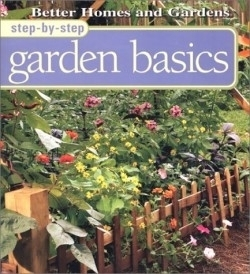Step-by Step Garden Basics
Everyone who gardens knows it is a continuous learning process. Like all learning, it has to start somewhere. For beginning gardeners, this often means consulting many different books to glean basic information on all the various aspects of growing plants. It also means lots of learning by doing. While this new addition to the Meredith Books / Better Homes and Gardens stable of gardening books can’t provide the experience needed to turn a beginner into a seasoned gardener, it can and does provide information and inspiration to start someone down that path.
Here in one volume is basic information on a wide variety of gardening topics, vegetable gardening as well as flower gardening and landscaping. Easily accessible and highly readable, this is a good book for someone who is ready to take the plunge into the wonderful world of gardening but doesn’t know where to start.
The book is organized according to the seasons. Spring, as one might expect, focuses on planting and transplanting, but also includes extending the season with cold frames, cloches or row covers, dividing perennials and bulbs and supporting vegetables and flowers. In summer the focus is on controlling garden pests and weeds, but container gardening, harvesting vegetables and encouraging blooms also get covered. Fall is time to store the harvest, plant fall perennials and bulbs, winterize roses and garden tools and put the garden to bed. It’s also the time for drying flowers, forcing bulbs indoors and making leaf mold. Winter is mostly about pruning, but also includes growing amaryllis and paperwhites indoors, and forcing branches to bloom. Each seasonal section includes a regional checklist of things to do. There are separate lists for cool climates and warm climates, and each of these are broken down into separate categories for trees and shrubs, annual flowers, perennials and vegetables. This is a useful way to keep track of all the garden chores that need to be done, and when to do them.
As the title suggests, there are step-by-step instructions for many garden projects, accompanied by lists of materials needed, tables, color photos and useful tips. The instructions are clear and concise, and the photographs vividly illustrate the ideas. Some of the tips may seem self-evident or even silly to anyone who’s been gardening for more than a week, such as the instructions for handpicking weeds, “Grasp the weed stem at the soil level between your thumb and forefinger. Pull with a steady, gentle pressure to coax the entire root out of the ground,” but most of them are informative and useful even to someone who’s been gardening for years. The novice gardener will get a broad, general overview of the topic, enough to get started without getting overwhelmed by all the details. In the section on planting vegetables, for example, a sidebar mentions crop rotation as a way to help control disease and insect problems. Not enough information is included to really do a thorough job of it, but the concept is at least introduced and briefly explained.
Weather tips appear throughout the book, such as this one that accompanies the instructions for digging and dividing host as: “Divide plants late in the day or when the sky is overcast. Protection from the sun will spare them additional stress during the process and once they’re replanted.” Common sense, maybe, but also a useful reminder to someone who is just getting started.
While this is not strictly an organic gardening guide, many of the principles are here. Many pages are spent on adding organic matter to the soil, making compost and the importance of mulching. Pesticides are not totally banned from the book, but it is recommended that they be used very carefully and only as a last resort.
The book starts off with a brief description of various types of gardens. This is followed by a brief introduction to some basic gardening principles and step-by-step instructions for making a cutting garden. A list of “best cutting garden flowers” is an example of the plant lists that occur throughout the book. A section at the end of the book called “Gardening Basics” covers such things as climate (with hardiness zone and frost date maps), tools, soil amendments, fertilizers, reading a plant tag, digging a garden bed, composting and garden ornaments. It also includes two pages of graph paper to draw garden plans, and space to keep track of the plants in the garden, with name, date planted, location and comments.
For a beginning gardening guide, this book covers a lot of ground. While the interested gardener may still want to consult other sources for more detailed information on some topics, all the basics are here.
Reviewed by
Dean Conners
Disclosure: This article is not an endorsement, but a review. The publisher of this book provided free copies of the book to have their book reviewed by a professional reviewer. No fee was paid by the publisher for this review. Foreword Reviews only recommends books that we love. Foreword Magazine, Inc. is disclosing this in accordance with the Federal Trade Commission’s 16 CFR, Part 255.

